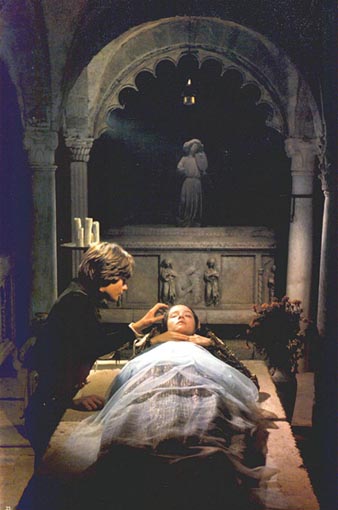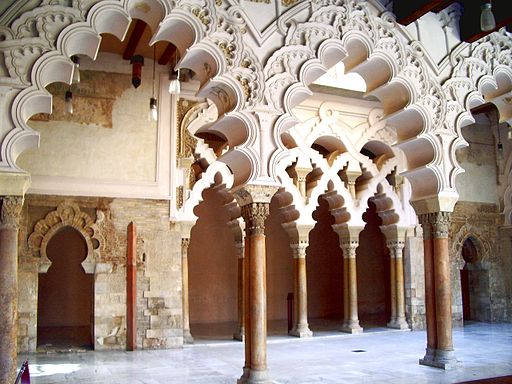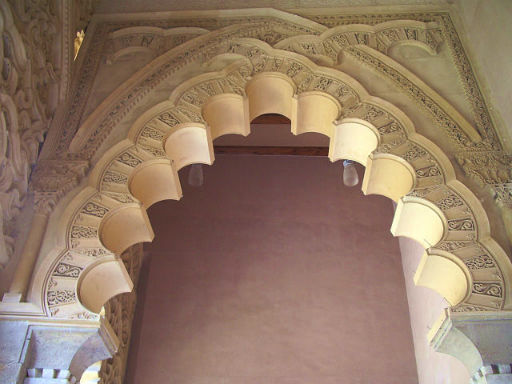
Ataurique
アラベスクとアタリウク
 2012-03-14
「アラベスク(arabesque)」については 用語事典でみてきました。
2012-03-14
「アラベスク(arabesque)」については 用語事典でみてきました。
「アラベスク」はなじみのある言葉ですが、今回、「アタリウク(ataurique)」という語を発見し、見ています。検索するとスペイン語サイトがヒットしますが、Wikipediaの英語版にこの項目はありません。スペインのWikipediahttp://es.wikipedia.org/wiki/Arte_taifaに、上記の化粧パネルとその紹介のキャプションにこの語が出てきます。
アタリウクとは
WEB検索■http://freeimagefinder.com/pic/ataurique.html
これのみヒット。
■http://fr.wiktionary.org/wiki/ataurique#enアラビア語tawriq 葉(feuillage)から派生した・・「定型化された植物のモチーフ」
「葉っぱのアラベスク」ということのようです。(スペイン語でアタリウクをひくとアラベスクに転送される。)
ヒスパニアムーア人hispanomauresqueとモサラベのモスクのスタイル。
[ 奇妙な葉の形、花、果物、リボン、動物を模した幾何学的形状とパターンのモチーフを指し、モスクのようなアラブの建物の壁に多くある。] アラビア人よりアラベスクの方が古いとある。
■http://en.wikipedia.org/wiki/Arabesque_(Islamic_art)イスラム美術唐草模様に、
アラベスク
=唐草の用語使用の歴史解釈もあり、
ヨーロッパのアラベスクhttp://en.wikipedia.org/wiki/Arabesque_(European_art)とムーア人のアラベスクーhttp://en.wikipedia.org/wiki/Moresqueは別に項目がある。
そしてもう一つ、中世スペインの「ムデハル様式」
http://en.wikipedia.org/wiki/Islamic_interlace_patterns
(この項目はArabesque_(Islamic_art)に統合削除の方向のようだ)
the Oxford English Dictionary : A species of mural or surface decoration in colour or low relief, composed in flowing lines of branches, leaves, and scroll-work fancifully intertwined. Also fig[uratively]. As used in Moorish and Arabic decorative art (from which, almost exclusively, it was known in the Middle Ages), representations of living creatures were excluded; but in the arabesques of Raphael, founded on the ancient Græco-Roman work of this kind, and in those of Renaissance decoration, human and animal figures, both natural and grotesque, as well as vases, armour, and objects of art, are freely introduced; to this the term is now usually applied, the other being distinguished as Moorish Arabesque, or Moresque.
moresque: ムーア人に関連があることまたは特徴 (relating to or characteristic of the Moors)ムデハル様式http://en.wikipedia.org
 アロイス・リーグルを補完するものとして
ジェシカ・ローソンによる中国のモチーフの研究を挙げているが、どうなのだろう..
アロイス・リーグルを補完するものとして
ジェシカ・ローソンによる中国のモチーフの研究を挙げているが、どうなのだろう..
The detailed study of Islamic arabesque forms was begun by Alois Riegl in his formalist study Stilfragen: Grundlegungen zu einer Geschichte der Ornamentik (Problems of style: foundations for a history of ornament) of 1893, who in the process developed his influential concept of the Kunstwollen.Riegl traced formalistic continuity and development in decorative plant forms from Ancient Egyptian art and other ancient Near Eastern civilizations through the classical world to the Islamic arabesque; while the Kunstwollen has few followers today, his basic analysis of the development of forms has been confirmed and refined by the wider corpus of examples known today.
Jessica Rawson has recently extended the analysis to cover Chinese art, which Riegl did not cover, tracing many elements of Chinese decoration back to the same tradition; the shared background helping to make the assimilation of Chinese motifs into Persian art after the Mongol invasion harmonious and productive.


Capiteles de la Aljafería
 あの映画(ロミオとジュリエットbyゼフィレッリ1968の墓所・・
馬蹄形のレースのようなアーチが美しかった。
あの映画(ロミオとジュリエットbyゼフィレッリ1968の墓所・・
馬蹄形のレースのようなアーチが美しかった。

トゥスカニアのサン·ピエトロの教会 だそうだが、ロケーション研究のhttp://www.romeo-juliet-club.ru/の写真ではないので、演出のようだ

Multifoil arches(多葉アーチ)

1259年に建築され、テルエルのムデハル様式の中では最古のもので、外壁は、レンガと彩色タイルで埋め尽くされている。
大聖堂の天井は、野菜の模様、幾何学模様、エピグラフィア(碑銘学)模様というムスルマン文化の伝統が見られる。
http://www.fotosearch.com/photos-images/teruel.html
ムデハル(イベリア半島出身者のイスラム教徒)
Wikipediaムデハル様式 (estilo mudéjar) はアラビア語で残留者を意味する「ムダッジャン」に由来する。スペインの建築様式で、レコンキスタ(718年から1492年までに行われたキリスト教国によるイベリア半島の再征服活動の総称)の後、残留イスラム教徒(スペイン語:mudéjar、mudajjan)の建築様式とキリスト教建築様式が融合したスタイル。特徴は建物の壁面に幾何学文様の装飾を施している。
 アラベスクの方を検索おさらいすると..
アラベスクの方を検索おさらいすると..
イスラム教徒が装飾品にあしらっていた模様である唐草模様
アラベスク - Wikipedia
アラベスク(arabesque)は、モスクの壁面装飾に通常見られるイスラム美術の一様式で、幾何学的文様(しばしば植物や動物の形をもととする)
「アラベスク」ってどういう意味ですか。 - Yahoo!知恵袋
http://detail.chiebukuro.yahoo.co.jp/
一般的には、アラビア風、という意味で、
具体的には、イスラム美術における装飾模様。
植物が絡み合った蔦模様や、星形の組み合わせなど、複雑かつ規則的、もしくは幾何学的な図案。
三省堂 大辞林
http://www.weblio.jp/content/Arabesque
アラベスク [(フランス) arabesque]
(1)イスラム美術の装飾文様。偶像禁止の教義により、植物の蔓(つる)・葉・花の図案化、星形の展開など、対称性に富む文様が発達した。ルネサンス期以降のヨーロッパにも広まった。
(2) (1) を思わせるような装飾的かつ技巧的な器楽曲。
*以上を見る限りでは、アラベスクを単に「唐草」と訳してはならない。あるいは唐草を単に「アラベスク」と訳してはならない。
アラベスク(美術)
百科事典マイペディアの解説
装飾文様の一種。フランス語で〈アラビア風〉の意。狭義にはイスラム美術にみられる,つる草に似た優美な曲線の交錯の中に,様式化した植物をモチーフとして採り入れた左右相称の文様。
英語版Wikipediaでは「アラベスク」を2つに分けている。
「いくつかの欧米のアラベスクは、イスラム美術から派生したが、他は密接に古代ローマの装飾に基づいています。」・・・
・・「ローマンスクロール」である。
| INDEX | アカンサス | ツタ | ロータス | ブドウ | ボタン | ナツメヤシ |




